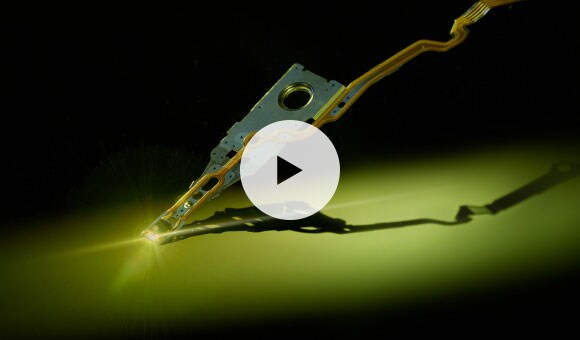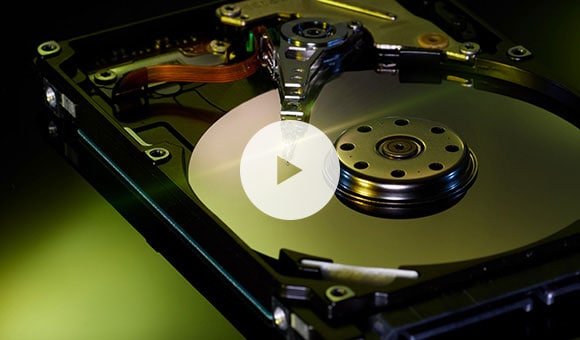How has one of Japan’s
oldest
university-derived
venture companies
continued its success?
TDK is currently a world-leading, multinational electronics and technology company headquartered in Tokyo
with 100,000 Team Members (employees)* and sales of two trillion yen*.
It began in a small factory
and is one of Japan’s oldest
university-derived venture
companies.
Our pioneer founder, Kenzo
Saito, proclaimed, “Contribute to culture and industry
through creativity”
and we
continue to provide
innovative products to the
world with that spirit.
Within this are seven projects
that brought about great
value globally,
and by discovering these, our
driving force, which continues
today, is unveiled.
*FY March 2023
TDK Venture Spirit
Episode #2
HDD Magnetic Head
*This content is produced in partnership with CNN International Commercial.
Behind the Data Boom: A Story of Bold Decisions and Visionary Minds
How business and technological gambles, driven by an unwavering venture spirit, reshaped hard disk drive technology for the digital world.
When the first hard disk drive (HDD) for computers became commercially available in 1956, it was a refrigerator-sized component capable of storing just five megabytes of data. This bulky, early iteration of the HDD was a far cry from the compact, high-performance data-storage systems that power the world today, and a key to this transformation lies in a tiny yet crucial component known as the magnetic head. This small piece of technology is where TDK's Takehiro Kamigama, relying on innovative prototypes developed by engineer Joichiro Ezaki, took strategic gambles that would advance data storage and shape the digital world we know today.
Foreseeing the Digital Future
Responsible for reading and writing data on an HDD, the magnetic head is a key component in determining the device’s data storage capacity. Early magnetic heads were made with materials such as ferrite, which had constraints that limited miniaturization. In 1984, TDK’s engineer Joichiro Ezaki developed a magnetic head prototype using malleable thin film materials. As this material could be cut into small pieces, the prototype could read data more finely, thereby increasing the storage capacity of HDDs.
Driven by a strong conviction that these new magnetic heads were the future, Ezaki requested several billion yen—constituting approximately 15% of TDK’s annual capital investment—to establish a designated research and development facility for this technology. Despite the financial uncertainty, as the prototype had yet to prove profitable for TDK, the company’s leadership was won over by Ezaki’s vision and invested in the opening of the Asama Techno Factory in Nagano, Japan. But three years after its opening, the factory failed to turn a profit. With pressure mounting, Ezaki and his team remained steadfast in their belief that thin-film magnetic heads would soon become vital in the digital age. And in 1990, TDK's gamble finally paid off.
Leading the Way with Technology
With the rise of personal computing, the digital world grew rapidly during the last decade of the 20th century. Manufacturers needed HDDs that could store more data, making innovative HDD heads essential. TDK's magnetic head sales reached $20 million ($4 billion yen) in 1990, more than triple the figure from two years prior, and became the company's primary business by 1995.
It was at this time that a new visionary emerged at TDK to drive the company forward. Takehiro Kamigama, who would later become the CEO of TDK, played an instrumental role in advancing the quality and production of the company’s magnetic heads. Not content with merely fulfilling clients’ orders, Kamigama studied and evaluated magnetic heads directly so he could learn how to create a truly industry-leading product.
Kamigama was later assigned to SAE Magnetics, a Hong Kong-based company TDK acquired to keep up with the skyrocketing demand for magnetic heads. The acquisition was not without its challenges; many SAE employees resigned after being taken over by a foreign company, and morale was low among the remaining staff. The core team, which included members from Japan, China, and Taiwan, was also confronted by language barriers and clashing business practices that stifled productivity. To overcome this, Kamigama promoted an open office dynamic that embraced each team member’s strengths and leveraged their shared passion for technology. Under Kamigama’s leadership, the once-divided team found strength and unity in its diversity.
Innovation Through Competition
After instilling a positive and open work culture at SAE, Kamigama turned his attention to the synergy between the development and production teams involved in TDK’s magnetic heads business. In a bold move, he proposed that TDK acquire Headway Technologies, an American competitor that also manufactured thin-film magnetic heads. Even though Headway operated as a similar research and development facility to TDK’s own Asama Techno Factory, Kamigama believed that its acquisition would help boost front-end development, which would be essential if TDK wanted to become the leading manufacturer of magnetic heads.
Kamigama’s innovative thinking led to an internal competition system between Asama and Headway that motivated all teams to strive for better results. The two facilities were tasked with developing their own magnetic heads, and TDK would choose which site to use based on each client’s needs. The site chosen would begin processing the client's order, while the site not selected would begin the next phase of R&D to improve its product. Through this process, TDK was able to shorten lead times and accelerate innovation, propelling the company to become an industry leader in the field of magnetic heads.
Leveraging his experience at SAE, Kamigama was able to unite teams beyond their cultural differences, enabling TDK's engineers to learn from one another. Striving to further boost the quantity and quality of magnetic heads, Kamigama held regular development meetings that gave the Headway and Asama teams a chance to share knowledge and best practices.
TDK’s acquisition of Headway contributed to the continued and accelerated data storage increase of HDDs and opened up new ways for technology to enrich our lives. The company’s rise as the leading provider of magnetic heads—a crucial component behind this data boom—was fueled by both the groundbreaking ideas and business practices enacted by Kamigama as well as the industry foresight demonstrated by Ezaki. Together, they exemplify the relentless venture spirit that empowered TDK to break free from conventional thinking and chart a path to success. With the rise of cloud storage, 5G communications, and IoT devices, the need for new advancements in HDD storage is as important as ever. As TDK continues to create value by elevating the possibilities of magnetic head technology, it remains a significant player in shaping our digital present and future.















